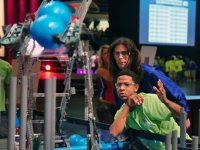Make Fuzzy Concepts Clear With Tech
When a Sphero robot engaged students’ empathy about Depression-era migrants, one teacher realized how using technology can help open young minds to abstract concepts.
Your content has been saved!
Go to My Saved Content.Richard Perry knew that he had a problem in his AP language and composition class -- the test was still months off, and the students were not getting into The Grapes of Wrath at all. While Steinbeck was busy cutting through the Horatio Alger fairy tale of the American Dream by chronicling the Joads' journey, his students were not feeling it.
"They were out of touch with struggle and failure," Richard explains. "In their world, if you were a good person, everything works itself out." Forget being able to talk about figurative language. Richard's students couldn't get through the reading on the level of plot because they didn't empathize with the characters at all.
Robots and Empathy
Anyone who has worked to get high school students to understand a different time and place through literature knows this struggle, the wall you hit when students tell you that they just don't get it. This is what keeps teachers up at night, and becomes a voice in the back of your head asking, "What can I do to change this?"
One afternoon in the midst of this particular struggle, Richard was meeting with the art teacher in his capacity as a district technology mentor. The subject was robots -- their school had written a grant for some Sphero robots, and it had just been funded. When the robots arrived, Richard's plan was to create a cross-curricular lesson with the art teacher. As they discussed ideas, Richard watched a student building something out of paper mache off to the side of the room, and he connected his pedagogical need with the resource at hand. That weekend, he designed and built a foam board and fake turf model of the Sierra Nevada mountains.
When the students came into the classroom and saw this model and the robot, Richard gave them their challenge. They had to navigate the robot over the mountains, just as the Joads had to navigate the dangerous landscape in their journey. "There was one moment when everything shifted," he reflects. "A student held up the robot and asked if we could name it." Through the rather unlikely process of driving a robot through an obstacle course, Richard's students began to understand the countless difficulties that the Joads faced in an era when few people had even heard the word "robot."
By using a robot and a home-built model mountain to make something abstract much more concrete for his students, Richard had constructed a learning challenge that not only required students to try and try again, it inspired them to keep trying.
4 Tips for Introducing High-Engagement Tools
We are teaching in a new age of hands-on learning tools, from tablet computers to 3D printers and robots. Teachers are always discovering new tools and innovating new ways to use them. Innovation is about problem solving.
Where do your students get lost in abstraction? Maybe it's in solving math problems, or understanding how molecules behave in different states of matter, or something more nebulous like empathizing with characters from literature.
When we keep our original learning focus and shift it to a different medium, we give more students access to the concepts that we are pursuing with them. In Richard's class, they continued text analysis and close reading, but the robot challenge significantly changed the conversation.
This is a great entry point for many of the alternative pedagogical approaches out there: design thinking, making in the classroom, programming to learn, or robots. How can you get started using a new high-engagement tool in a meaningful way?
- Identify what isn't working. Find a problem or concept that your students are currently struggling to understand.
- Make the abstract concrete. Create a learning experience that allows students to interact physically with something that you had previously only discussed or looked at.
- Keep the challenge real. Make sure that there is success to be found in the activity, but don't make it easy. A genuine challenge that requires students to work together will foster greater understanding as well as develop your classroom community.
- Allow students to share their successes as well as their failures.
How do you make the abstract concrete in your classroom? Share your ideas below to inspire others, and be sure to check back on their comments to get some inspiration yourself.
